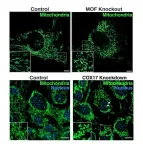(Press-News.org) *EMBARGOED UNTIL 11 A.M. MONDAY, OCT. 9*
Liquid biopsies are blood tests that can serially measure circulating tumor DNA (cell-free DNA that is shed into the bloodstream by dying cancer cells). When used in patients with advanced non-small cell lung cancer undergoing immunotherapy, they may identify patients who could benefit from treatment with additional drugs, according to a phase 2 clinical trial in the U.S. and Canada. The trial is led by investigators at the Johns Hopkins Kimmel Cancer Center and its Bloomberg~Kimmel Institute for Cancer Immunotherapy, BC Cancer and the Canadian Cancer trials Group (CCTG).
The results, published October 9 in the journal Nature Medicine, suggest that ctDNA analyses could be used as an early marker of immunotherapy response and may help guide therapy.
Immunotherapies are drugs which unharness the power of the immune system against cancers. Despite their success in improving survival, they pose a challenge to the standard use of imaging to determine treatment response because changes in imaging may not always reflect how well immunotherapy is working. Liquid biopsies may help determine which patients are benefiting from available immunotherapies and could be a new endpoint for clinical trials testing these treatments. Although initial reports are promising, how these approaches can best be used has not been established through a clinical trial.
The BR.36 clinical trial (NCT04093167) is designed to establish the role of ctDNA as an early measurement of immunotherapy response by first, defining ctDNA response, its timing and how it compares with the gold standard of imaging tests and then by using ctDNA response to guide treatment for patients with advanced non-small cell lung cancer.
The first stage of the BR.36 trial found that by serial testing ctDNA using next-generation sequencing (an advanced technology that can rapidly sequence millions of gene targets), immunotherapy responses were detected early, within an average of eight weeks after treatment started. A ctDNA response (ctDNA no longer detected in the blood) reflected tumor shrinkage by imaging, however, there were notable exceptions that showed that ctDNA response may capture survival more accurately, especially for patients with stable disease on imaging.
Compared to patients who did not have a ctDNA response, patients with a ctDNA response had a longer progression-free survival (the time in which the disease does not worsen), a difference of 2.6 months versus 5.03 months respectively. In addition, patients with a ctDNA response had a longer overall survival, with median survival not reached at the time of analysis.
“There is an unmet clinical need to implement real-time, minimally invasive molecular analyses to understand patients’ responses to cancer treatments and guide clinical decision-making,” says lead study author Valsamo “Elsa” Anagnostou, M.D., Ph.D., director of the thoracic oncology biorepository at Johns Hopkins, leader of Precision Oncology Analytics, co-leader of the Johns Hopkins Molecular Tumor Board and co-director of the Lung Cancer Precision Medicine Center of Excellence. “Our study demonstrates that ctDNA response correlated with tumor size seen on imaging, which is the gold standard for monitoring response to cancer treatments and seemed to be better correlated with survival. This suggests ctDNA could be used as a strategy to identify patients at high risk of disease progression who could benefit from a switch in their therapeutic regimen.”
Investigators hypothesized that liquid biopsies would rapidly and accurately predict outcomes for patients. During the first stage of the BR.36 study, investigators enrolled 50 patients with advanced or metastatic non-small cell lung cancer at six medical centers in the U.S. and Canada, between May 2020 and September 2022. Nearly all patients had been smokers, and 92% received no prior therapies. The group was 82% white, 52% female and 56% age 65 or older. The goals were to identify the optimal timepoint for ctDNA molecular response and to see how well molecular response correlated to response evaluation criteria in solid tumors (RECIST), the standard for measuring response to cancer treatment by monitoring changes in tumor size as seen on imaging.
Patients received the immunotherapy drug pembrolizumab based on standard of care, at a 200 mg or 2 mg/kg infusion every three weeks. After the first three cycles, investigators could switch to a 400 mg or 4 mg/kg infusion every six weeks. Patients remained in the trial until they received 24 months of therapy, had unacceptable drug toxicity, or imaging tests revealed progression of disease.
Investigators performed RECIST response assessments every six weeks until week twelve, and at longer intervals thereafter. They also collected blood samples from patients prior to treatment administration on the first day of the first cycle (baseline), the first day of the second cycle (three weeks into treatment) and the first day of the third cycle (six weeks) of treatment. These were used to conduct a ctDNA response assessment at these timepoints and to define molecular response as ctDNA clearance on the first day of the third cycle of treatment with pembrolizumab. Analyses of molecular response were assessed using the Personal Genome Diagnostics (PGDx) elio liquid biopsy platform, which “represents an exciting opportunity for tailoring immunotherapy to enhance the interpretation of patterns of tumor response and progression during treatment,” states Mark Sausen, Ph.D., executive director and head of technology innovation, PGDx, Labcorp.
“ctDNA response is particularly informative to understand the complexity of stable disease on imaging, which represents a sizable fraction of patients in whom imaging fails to timely and accurately detect the magnitude of therapeutic response,” Anagnostou says.
Implementing the results from the first stage of the BR.36 trial, investigators moved forward with the second stage of the trial, in which they will evaluate the potential clinical benefit of tailoring treatment for patients with lung cancer based on their ctDNA responses after two cycles of pembrolizumab treatment. ctDNA response will be used to identify patients with lung cancer at high risk for disease progression, who will be subsequently randomized to treatment intensification with pembrolizumab and chemotherapy versus continuation of pembrolizumab.
“The Cancer Research Institute (CRI) is pleased to invest in Stage 2 of this clinical trial,” says Jay Campbell, managing director of the CRI Anna-Maria Kellen Clinical Accelerator. “This is being designed as a registrational study, meaning if the study meets its primary endpoint, the ctDNA detection assay used in the BR.36 study could be approved. This could lead to molecular assessment by liquid biopsies becoming the standard means of assessing whether first-line patients with non-small cell lung cancer are responding to cancer immunotherapies, compared to conventional radiographical assessment of response.”
Janet Dancey, M.D., director of the Canadian Cancer Trials Group, states, “ctDNA has the potential to improve our ability to advise patients on the best treatment options for them. It may be better than traditional imaging in determining changes to treatments or providing assurance that patients should continue their current treatment. Our initial study indicates promising results, and we will move forward with a larger trial to clearly show whether ctDNA monitoring provides useful information based on treatment recommendations.”
Study coauthors were Cheryl Ho, Canadian Study Chair of BCCA-Vancouver Cancer Centre in British Columbia, Canada, and Benjamin Levy, Julie Brahmer, Archana Balan and Noushin Niknafs of Johns Hopkins. Other authors were from Ottawa Hospital Research Institute in Canada; Juravinski Cancer Centre in Hamilton, Canada; Princess Margaret Cancer Centre in Toronto, Canada; Kingston Health Sciences Centre in Kingston, Canada; Canadian Cancer Trials Group in Kingston, Canada; Personal Genome Diagnostics (Labcorp) in Baltimore; and the Cancer Research Institute in New York, N.Y.
The trial was funded by the Cancer Research Institute, the Mark Foundation for Cancer Research and Personal Genome Diagnostics. The analyses were supported in part by the Canadian Cancer Society (grant 707213); the U.S. National Institutes of Health (grant CA121113) and the Commonwealth Foundation.
Anagnostou receives research funding to The Johns Hopkins University from Astra Zeneca and Personal Genome Diagnostics; has received research funding to The Johns Hopkins University from Bristol-Myers Squibb and Delfi Diagnostics in the past five years, and is an advisory board member for Astra Zeneca and Neogenomics. She is an inventor of several patent applications submitted by The Johns Hopkins University related to cancer genomic analyses, ctDNA therapeutic response monitoring and immunogenomic features of response to immunotherapy that have been licensed to one or more entities. Under the terms of these license agreements, the university and inventors are entitled to fees and royalty distributions. These relationships are managed by The Johns Hopkins University in accordance with its conflict of interest policies.
END
Capturing immunotherapy response in a blood drop
2023-10-09
ELSE PRESS RELEASES FROM THIS DATE:
Soccer goalies process the world differently, muti-sensory integration tests show
2023-10-09
In the game of soccer (association football), goalkeepers have a unique role. To do the job well, they must be ready to make split-second decisions based on incomplete information to stop their opponents from scoring a goal. Now researchers reporting in Current Biology on October 9 have some of the first solid scientific evidence that goalkeepers show fundamental differences in the way they perceive the world and process multi-sensory information.
“Unlike other football players, goalkeepers are required to make thousands of very fast decisions based on limited or incomplete sensory information,” says Michael Quinn, the study’s ...
Depressive symptoms and mortality among adults
2023-10-09
About The Study: This study of 23,000 individuals found a higher risk of all-cause, cardiovascular disease, and ischemic heart disease mortality among adults with moderate to severe depressive symptoms compared to those without depressive symptoms. Public health efforts to improve awareness and treatment of depression and associated risk factors could support a comprehensive, nationwide strategy to reduce the burden of depression.
Authors: Zefeng Zhang, M.D., Ph.D., of the Centers for Disease Control and Prevention in Atlanta, is the corresponding author.
To access the embargoed study: ...
Estimates of major depressive disorder and treatment among adolescents by race and ethnicity
2023-10-09
About The Study: During the first full calendar year of the pandemic, approximately 1 in 5 adolescents had major depressive disorder, and less than half of adolescents who needed treatment had any mental health treatment, according to this analysis of nationally representative survey data of 10,000 U.S. adolescents. Adolescents in racial and ethnic minority groups, particularly Latinx, experienced the lowest treatment rates.
Authors: Michael William Flores, Ph.D., M.P.H., of the Cambridge Health Alliance in Cambridge, Massachusetts, is the corresponding author.
To access ...
Cancer drug restores immune system’s ability to fight tumors
2023-10-09
A new, bio-inspired drug restores the effectiveness of immune cells in fighting cancer, a team led by researchers at The University of Texas at Austin has found. In mouse models of melanoma, bladder cancer, leukemia and colon cancer, the drug slows the growth of tumors, extends lifespan and boosts the efficacy of immunotherapy. The research is published in the journal Cancer Cell and could be a game changer for many cancer patients.
Many cancers delete a stretch of DNA called 9p21, which is the most common deletion across all cancers, occurring in 25%-50% of certain cancers such as melanoma, bladder ...
Newfound mechanism suggests drug combination could starve pancreatic cancer
2023-10-09
A new combination of treatments safely decreased growth of pancreatic cancer in mice by preventing cancer cells from scavenging for fuel, a new study finds.
Led by researchers at NYU Grossman School of Medicine, its Department of Radiation Oncology, and the Perlmutter Cancer Center, the work builds on prior discoveries at NYU Langone that revealed how pancreatic cancer cells, to avert starvation and keep growing, find alternate fuel sources. Normally supplied by the bloodstream, oxygen, blood sugar, and other resources become scarce as the increasing density of fast-growing pancreatic tumors cuts off their own blood supply. ...
Epigenetic regulator MOF drives mitochondrial metabolism
2023-10-09
The intricate control of cellular metabolism relies on the coordinated and harmonious interplay between the nucleus and mitochondria. On the one hand, mitochondria are the hub for the production of essential metabolites, which aside from being required to meet the energy demands of the cell, also serve as the building blocks for constructing both genetic and epigenetic landscapes in the nucleus. On the other hand, the majority of mitochondrial metabolic enzymes are encoded by the nuclear genome, making the function of these two organelles highly interdependent on one another. Inter-organellar communication is aided by molecules that shuttle between these two compartments. ...
Do you know a stroke hero?
2023-10-09
Each year, approximately 800,000 people in the U.S. experience a stroke, according to the American Heart Association’s 2023 Heart Disease and Stroke Statistical Update. Individuals and groups making a difference in the stroke community have a chance to be nationally recognized with a 2024 Stroke Hero Award from the American Stroke Association, a division of the American Heart Association, which is devoted to a world of healthier lives for all.
Stroke is the fifth leading cause of death and a leading cause of serious, long-term ...
UofL receives $16 million to increase supply of primary care physicians for underserved rural and urban areas
2023-10-09
The University of Louisville has received $16 million to help increase Kentuckians’ access to health care, particularly in underserved rural and urban areas. The UofL School of Medicine will use the funds from a four-year grant from the Health Resources and Services Administration (HRSA) to train more primary care physicians and encourage them to practice in underserved communities where they are needed.
Kentucky has a severe shortage of health care providers, with at least some portion of 113 of the state’s 120 counties designated as Health Professional Shortage Areas, including ...
TAVR: Less than one-third of patients enter cardiac rehab after heart procedure
2023-10-09
The vast majority of people who have a minimally invasive heart valve replacement procedure do not participate in recommended cardiac rehabilitation, a Michigan Medicine-led study finds.
Researchers used clinical registry and health care claims data from over 3,300 patients who underwent transcatheter aortic valve replacement, or TAVR, in Michigan across 24 hospitals between 2016 and mid-2020, to determine the rate of cardiac rehabilitation participation and the factors associated with its utilization.
Results published in JACC: Advances reveal that just 30.6% ...
Newly-discovered “margarita snails” from the Florida Keys are bright lemon-yellow
2023-10-09
The “Margaritaville” in Jimmy Buffett’s famous song isn’t a real place, but it’s long been associated with the Florida Keys. This string of tropical islands is home to the only living coral barrier reef in the continental US, along with many animals found nowhere else in the world. One of them is a newly-discovered, bright yellow snail, named in honor of Margaritaville. The lemon- (or, key-lime-) colored snail, along with its lime-green cousin from Belize, is the subject of a study published in the journal PeerJ.
These marine snails are distant relatives of the land-dwelling gastropods you ...




